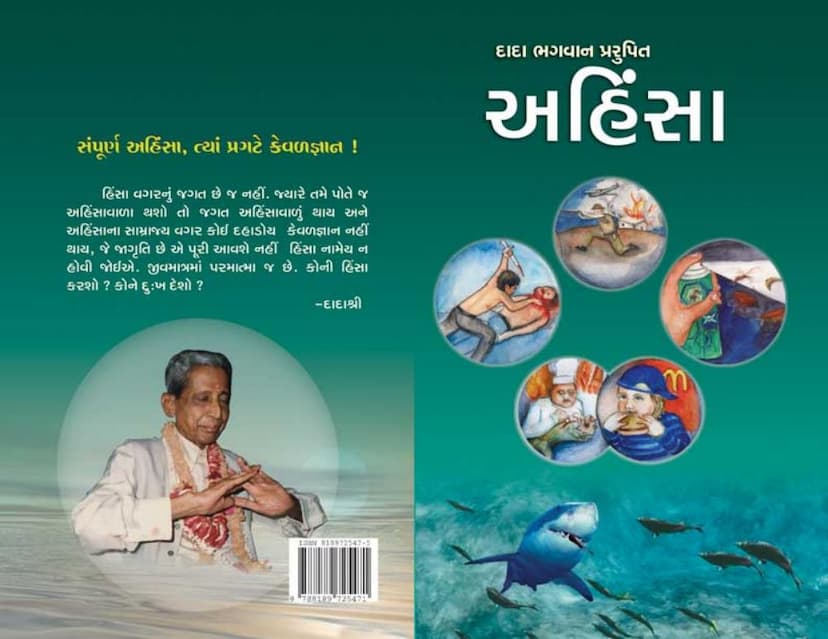Ahimsa
Added to library: September 1, 2025

Summary
Here is a comprehensive summary of the Jain text "Ahimsa" by Dada Bhagwan, based on the provided pages:
Book Title: Ahimsa Author: Dada Bhagwan (Param Pujya Dadashri) Publisher: Dada Bhagwan Foundation
Core Message of Ahimsa:
The book "Ahimsa" by Dada Bhagwan emphasizes that true and complete Ahimsa (non-violence) is the path to achieving Kevalgyan (omniscience). The essence of the teachings is that while external acts of violence are common, the subtlest and most profound form of violence is Bhavahimsa (mental violence), which stems from negative thoughts, anger, pride, deceit, and greed (Kashays). True Ahimsa extends to thoughts, words, and deeds, aiming to cause no pain whatsoever to any living being.
Key Concepts and Teachings:
- Ahimsa is the ultimate Dharma: Ahimsa is presented not just as an ethical principle but as the very essence of Dharma and the key to spiritual progress.
- Beyond External Ahimsa: While avoiding harm to physical beings is important, the book stresses the paramount importance of Bhavahimsa. The teachings aim to help individuals eradicate the roots of violence within their own thoughts and intentions.
- The Nature of Violence: Violence is categorized from gross physical violence (Dravyahimsa) to the subtlest mental violence (Bhavahimsa). The text highlights that internal violence, particularly through Kashays (anger, pride, deceit, greed), is far more damaging and creates greater karmic bondage.
- The Role of the Self (The Soul): Dada Bhagwan explains that in one's true Self (Shuddhatma), there is no possibility of violence. Violence occurs when one identifies with the body-mind complex (Chandubhai in the context of the teachings) and its desires and reactions.
- Understanding Karma: The book touches upon the principles of karma, explaining that actions, driven by intentions, create consequences. Forgiveness (Pratikraman) and repentance are offered as ways to mitigate karmic effects.
- Practical Guidance for Daily Life: The text offers practical advice on how to practice Ahimsa in everyday situations, including:
- Food: Discouraging consumption of meat, eggs, and root vegetables (Kandmool) due to the violence involved. The teachings advocate for a vegetarian diet and caution against causing harm even to one-celled beings in food preparation and consumption.
- Intention vs. Action: While acknowledging that some actions might inadvertently cause harm due to the nature of the world and one's current state of being, the focus is on purifying one's intentions and having the right spiritual awareness.
- Dealing with Insects and Pests: The teachings offer a unique perspective on dealing with common household pests like bedbugs, mosquitoes, and ants. Instead of killing them, the advice is often to remove them, tolerate them as karmic accounts, or take preventive measures without causing direct harm. The concept of "Tapo" (enduring discomfort) is introduced as a form of spiritual practice.
- Dealing with Difficult Situations: When faced with unavoidable harm or situations that involve violence (e.g., farming), the emphasis is on maintaining a state of equanimity, seeking forgiveness, and resolving to change the situation in the future.
- The Role of the Knower: When experiencing discomfort or pain, the practice recommended is to maintain awareness of the Self as a detached observer ("I am the Self, I am not the one experiencing this") and not identify with the pain or the agent causing it.
- The Importance of the True Self: The ultimate path to complete Ahimsa lies in realizing and abiding in the pure Self (Shuddhatma). Once one is established in the Self, external events and actions, even those that appear violent from a relative perspective, do not affect the Soul.
- Beyond Strict Adherence: The teachings often emphasize the internal shift in perspective and intention over rigid external observances, especially when they become a source of ego or conflict.
- Dada Bhagwan's Identity: The book includes an explanation of who Dada Bhagwan was, describing his spiritual awakening in 1958, his realization of the Self, and his ability to impart this Self-knowledge to others through his "Akram Vigyan" (unconditional path). He emphasized that the "Dada Bhagwan" within him was the Lord of the fourteen realms, residing in everyone, and he was merely a medium for its expression.
- The Subtle Nature of Ahimsa: The text distinguishes between gross violence and subtle violence, with mental violence (Bhavahimsa) being the most impactful. True Ahimsa requires eradicating negative mental states.
- "Ahimsa Paramo Dharma" (Non-violence is the Supreme Religion): This mantra is presented as a guiding principle for daily life, requiring conscious thought and repentance when unintentional harm occurs.
- The "Akram Vigyan" Path: This path offers a shortcut to Self-realization and the ability to practice Ahimsa by shifting one's internal perspective and identifying with the pure Soul, rather than the ego.
Key Takeaways:
- Inner Purity is Key: The ultimate aim is to achieve inner purity of thought, word, and deed.
- Self-Realization as the Solution: Understanding and abiding in the true Self is the foundation for true Ahimsa.
- Compassion and Non-Judgment: The teachings encourage compassion towards all beings and a non-judgmental attitude towards others' actions, recognizing that everyone is bound by their karma.
- The Power of Intention: The book stresses that it is the intention and inner state that primarily determine the karmic consequences, not just the external action.
The book "Ahimsa" serves as a profound guide for those seeking to understand and implement the deepest principles of non-violence as taught by Dada Bhagwan, leading towards spiritual liberation.